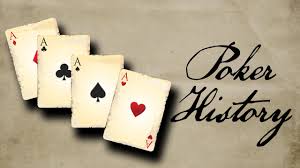Poker is one of the most popular card games in the world. Although the origins of poker are centuries old, poker is becoming more popular as its becoming part of mainstream television, and for online gambling is becoming increasingly popular in many parts of the world.
In the last few hundred thousand years the game of poker has dramatically changed, mainly because it has been germinated from many other games into the modern game of poker, which is a game of skill with a large element of deception. Therefore an understanding of the history of poker is important for understanding how the game has reached the level of popularity it has in today’s world.
According to historians and researchers, the history of poker began in the middle Ages. It was believed that the game was originated by the Italian brothers, who called the game lotto, which means fate or destiny. The game was first played in the Balmoral hotel in thenes area of Ireland, where it was believed that the rude gamblers would used ink daubers to mark their cards, and then eager players would win money. Over the years the Irish meant the game with the term crocca, which meant to turn a profit or a fortune, resulting in the gaining of innumerable tips, andimentals on the game.
By the 18th century the game had arrived in England, and within a few years had changed the face of gambling by making it more organized and more profitable. The royal family, the upper classes and the middle classes all got together to play the game, and they invested their time and money into betting on horse races, playing cards, dice games and other forms of gambling.
After the period that we know as the period offixibility,pokerwas able to transform itself from a nasty old game that was associated with people who were out for gambling and stuff to an organized, fair, legalized and highly organized game that was loved by all players. Poker was associated with the old English swear words that we’re still hearing today but the game itself had been changed significantly.
During the 19th century, the game of poker underwent many changes, and in the new century, there appeared new versions of poker, which were played in saloons. within a few years, the big money followed the game to the U.S. When the game of poker became big, saloons were legalized, and for the first time since the 1800’s women were given legal licenses to gamble.
The next big change in poker came when the state of Nevada legalized gambling in the city of Las Vegas (along with Reno and Atlantic City), and the cards, once again, were legalized. during this time, many famous poker player found themselves millionaires overnight.
Of course, by this time there were many types of poker games developed, such as stud or draw, community card poker, and other variations. History was playing a far greater part in poker, as it had become a very popular game, especially in the saloons of the 1910’s and 20’s.
By 1931 the true inception of the game of poker can be determined. It is believed the game began in the Middle East and were brought to the U.S. by the Middle Eastern people known as Middle Easterners or Middle Easterners (many of whom were Ethnics). The game of poker has evolved into different forms, most commonly played today in the casinos as Texas Hold’em No Limit, and in home games with friends and family.
The major milestone in the history of poker was achieved when the World Series of Poker was started. (In Texas Hold’em No Limit the wager can be made in coins. Hence the name “Texas Hold ’em”.) Before this, many small scale games had appeared, but when the professional gamblers appeared, the games were greatly increased. Many books were published about the strategies of the game.
The first time that a complete set of rules of the game of poker was published was in the mid 1940s by an individual known as Dr. Edward O. Thorp, which was an eminent card player, and with the help of associates funded by the profits they made through playing poker, Thorp introduced the complete Thorp’s Super System in Books and subsequently was mass produced and distributed to the public. However the book was only a small success, and when the poker boom began, distribution networks headed by E. Perry conventionalized the Thorp’s system and made it available to the public.
From the late 40’s, the poker boom developed, and the audience grew, and thanks to the flurry of poker on TV, the game prospected by most people was becoming a reality. The era between the advent of Statistics and the beginning of Hold’em No Limit is commonly known as the ” hitch,” “loose” or “Dewavegas” era.

